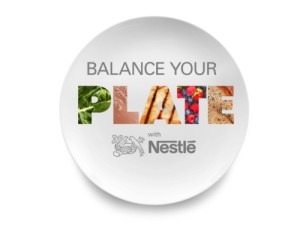 Food is inextricably bound up with health whether we are well or not. Several key area of the Food=Health ecosystem made the news this week which, together, will impact public and personal health.
Food is inextricably bound up with health whether we are well or not. Several key area of the Food=Health ecosystem made the news this week which, together, will impact public and personal health.
On the employer health benefits front, more media are covering the story on CVS strongly incentivizing employees to drop body mass index (BMI) through behavioral economics-inspired health plan design of a $50 peer month penalty.
 Michelin, whose bulky advertising icon Bibendum has more than one “spare tire,” introduced a program to combat health issues, including but not limited to BMI and high blood pressure, according to the Wall Street Journal on April 5, 2013. Michelin is using more of a stick than carrot approach, rewarding only those workers who “meet healthy standards for blood pressure, glucose, cholesterol, triglycerides and waist size — under 35 inches for women and 40 inches for men,” according to the article. If a worker achieves success in three or more of these metrics, they receive up to $1,000 to reduce their deductible expenses in a year. Six in 10 companies expect to use such penalties in their employee wellness programs, according to an Aon Hewitt survey.
Michelin, whose bulky advertising icon Bibendum has more than one “spare tire,” introduced a program to combat health issues, including but not limited to BMI and high blood pressure, according to the Wall Street Journal on April 5, 2013. Michelin is using more of a stick than carrot approach, rewarding only those workers who “meet healthy standards for blood pressure, glucose, cholesterol, triglycerides and waist size — under 35 inches for women and 40 inches for men,” according to the article. If a worker achieves success in three or more of these metrics, they receive up to $1,000 to reduce their deductible expenses in a year. Six in 10 companies expect to use such penalties in their employee wellness programs, according to an Aon Hewitt survey.
A different approach is being taken by NutriSavings, a system that tracks consumers’ grocery store purchases and calculates a nutrition quality score between 1 and 100. That score generates coupons that either nudge people to buy healthier foodstuffs or keep buying the same healthy goods. Employers who work with NutriSavings don’t see the worker’s individual grocery details, but do receive an aggregated report about how employees’ grocery shopping health behaviors. The theory is that over time, people will change food buying habits based on what NutriSavings considers “continuous education.”
Another venture marrying healthy eating to employees was announced between SavingStar and Edenred, an employee benefits vendor. The program features a couponing program based on grocery store purchases, similar to
 Humana’s alliance with Walmart, the Great for You label program, was covered in Workforce Management magazine to highlight HumanaVitality’s work with the Kentucky Employees’ Helath Plan. The incentive here is that the more consumers purchase products featuring the Good for You label, the more money they earn toward a purchase card that can be used to shop at Walmart. A further attraction is that the proceeds on the card can be used for any merchandise at Walmart, not only food. Another food touchpoint in health is the hospital. The Truman Medical Centers in Kansas City MO have opened a grocery store featuring healthy foods. he project started as a farmer’s market program open between April and November, which morphed into a weekly produce market, according to Healthcare Finance News of April 5, 2013. The hospital is allocating $11.5 million to its new full-service grocery store that will market wellness through carefully curated products. The hospital’s management cited the presence of food deserts in its target markets as a key motivation to launching the retail store. The store will also emphasize locally-sourced fresh food products, and ethnic foods that people in the area demand. The store plans to open in summer 2014.
Humana’s alliance with Walmart, the Great for You label program, was covered in Workforce Management magazine to highlight HumanaVitality’s work with the Kentucky Employees’ Helath Plan. The incentive here is that the more consumers purchase products featuring the Good for You label, the more money they earn toward a purchase card that can be used to shop at Walmart. A further attraction is that the proceeds on the card can be used for any merchandise at Walmart, not only food. Another food touchpoint in health is the hospital. The Truman Medical Centers in Kansas City MO have opened a grocery store featuring healthy foods. he project started as a farmer’s market program open between April and November, which morphed into a weekly produce market, according to Healthcare Finance News of April 5, 2013. The hospital is allocating $11.5 million to its new full-service grocery store that will market wellness through carefully curated products. The hospital’s management cited the presence of food deserts in its target markets as a key motivation to launching the retail store. The store will also emphasize locally-sourced fresh food products, and ethnic foods that people in the area demand. The store plans to open in summer 2014.
Nestle announced its Balance Your Plate campaign to promote the consumption of more fruit and vegetables, along with whole grain and low-fat dairy products. Nestle used the USDA’s 2010 Dietary Guidelines for Americans (DGA) with templates for 2,000, 1,800 and 1,500 daily calorie intake. According to NPD Group, Americans only meet these recommendations 7 in 365 days each year. Nestle also participates in the Healthy Weight Commitment Foundation along with over 100 food and beverage producers, retailers, restaurants, NGOs, sports organizations and insurance companies.
Finally, in its public health oriented Bridging the Gap series focusing on bolstering healthy youth, The Robert Wood Johnson Foundation (RWJF) published the research brief, Competitive Foods and Beverages in Elementary School Classrooms. These three pages pack a strong punch, targeting the USDA’s proposed new nutrition standards for “competitive foods and beverages,” those sold outside of federally reimbursable school meal programs. These policies don’t deal with the many forces shaping kids’ food behaviorss which, together, militate against health. For example, most schools have no school-wide restrictions on teachers using candy in lessons, and most use sugary items to be used as classroom rewards.
Health Populi’s Hot Points: Food is increasingly acknowledged to be a major risk factor in individual’s chronic conditions, from heart disease and many cancers to the complications of obesity (especially diabetes and other issues related to metabolic syndrome).
The many examples cited here, from various quarters of the health care ecosystem, converge on one key question: what are the rights of of the individual versus the community? Commons? Lifeboat? Taxpayer (whether at the school district level or Federal)? Pick your favorite noun for “health collective.” Does the U.S. have the stomach (sorry) to grasp the Food = Health challenge?
The U.S. has entered a new phase of public health — Public Health, writ large — where the practical health economics and national macroeconomics and companies’ global competitive advantage, are pressuring the nation toward behavioral economics yielding more sticks than carrots.




 I'm in amazing company here with other #digitalhealth innovators, thinkers and doers. Thank you to Cristian Cortez Fernandez and Zallud for this recognition; I'm grateful.
I'm in amazing company here with other #digitalhealth innovators, thinkers and doers. Thank you to Cristian Cortez Fernandez and Zallud for this recognition; I'm grateful. Jane was named as a member of the AHIP 2024 Advisory Board, joining some valued colleagues to prepare for the challenges and opportunities facing health plans, systems, and other industry stakeholders.
Jane was named as a member of the AHIP 2024 Advisory Board, joining some valued colleagues to prepare for the challenges and opportunities facing health plans, systems, and other industry stakeholders.  Join Jane at AHIP's annual meeting in Las Vegas: I'll be speaking, moderating a panel, and providing thought leadership on health consumers and bolstering equity, empowerment, and self-care.
Join Jane at AHIP's annual meeting in Las Vegas: I'll be speaking, moderating a panel, and providing thought leadership on health consumers and bolstering equity, empowerment, and self-care.